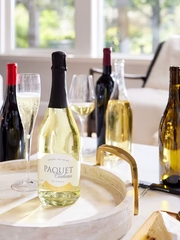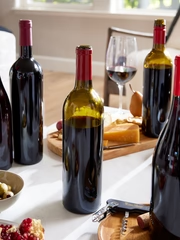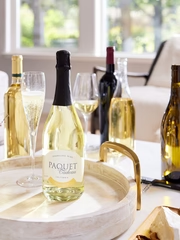 This could be a picture of an exotic super fruit from Brazil, a cat's toy or even a new character in the latest Minions movie. Yet this image is none other than a microscopic view of the yeast Saccharomyces cerevisiae.
Select yeasts are at the foundation of modern winemaking.
This could be a picture of an exotic super fruit from Brazil, a cat's toy or even a new character in the latest Minions movie. Yet this image is none other than a microscopic view of the yeast Saccharomyces cerevisiae.
Select yeasts are at the foundation of modern winemaking.
 Grapes are picked early morning and make their way to the cellar. After checking, the sugar content is expressed in degrees Brix. The sugar level matters, as we can calculate the final degree of alcohol for each wine pretty accurately at this stage. The grape clusters are loaded into a press. Undamaged clusters are needed for the best aromas and flavors in the future wine.
Grapes are picked early morning and make their way to the cellar. After checking, the sugar content is expressed in degrees Brix. The sugar level matters, as we can calculate the final degree of alcohol for each wine pretty accurately at this stage. The grape clusters are loaded into a press. Undamaged clusters are needed for the best aromas and flavors in the future wine.
 This year, I used a yeast called Melody. I chose this particular strain of yeast for the characteristics it will later develop in the wine. Melody is recommended for the enhancement of floral and tropical fruit aromas and rounded flavors in dry white wines, such as Chardonnay or Viognier.
Key Features of Melody:
This year, I used a yeast called Melody. I chose this particular strain of yeast for the characteristics it will later develop in the wine. Melody is recommended for the enhancement of floral and tropical fruit aromas and rounded flavors in dry white wines, such as Chardonnay or Viognier.
Key Features of Melody:
- Increases wine viscosity and fullness
- Alcohol tolerance is up to 17% (v/v)
- Produces low levels of SO2
 Vinilfora® Melody™ is a blend of three yeast strains, Saccharomyces cerevisiae (60%), Torulaspora delbrueckii (20%) and Lachancea thermotolerans (20%). Melody is well suited for dry white wines and higher-end Chardonnay.
Hydration and proper nutrition are key for all living organisms. Yeast needs a warm bath at 100° Fahrenheit to start expanding. After 20 minutes, a gallon of the freshly squeezed juice is added.
Vinilfora® Melody™ is a blend of three yeast strains, Saccharomyces cerevisiae (60%), Torulaspora delbrueckii (20%) and Lachancea thermotolerans (20%). Melody is well suited for dry white wines and higher-end Chardonnay.
Hydration and proper nutrition are key for all living organisms. Yeast needs a warm bath at 100° Fahrenheit to start expanding. After 20 minutes, a gallon of the freshly squeezed juice is added.
 The addition of fresh juice gives a huge boost of energy to those hungry microorganisms. A few minutes are also necessary to get this mixture to triple in size. After that, the time comes to add the slurry to the tank or directly into barrels.
The addition of fresh juice gives a huge boost of energy to those hungry microorganisms. A few minutes are also necessary to get this mixture to triple in size. After that, the time comes to add the slurry to the tank or directly into barrels.
 My wife Catherine has been observing her students at the Culinary Institute of America as they use yeasts to make all sorts of doughs. So, I put her skills to work. She did a great job whisking and mixing.
I am sure you did not know that the last two vintages of Chardonnays had a feminine touch, thanks to my two best friends: Melody and Catherine.
My wife Catherine has been observing her students at the Culinary Institute of America as they use yeasts to make all sorts of doughs. So, I put her skills to work. She did a great job whisking and mixing.
I am sure you did not know that the last two vintages of Chardonnays had a feminine touch, thanks to my two best friends: Melody and Catherine.





